Nonprofit Trade Association Business Plan
The Connecticut Motorsports Business Association (CMBA) is a nonprofit trade association of motorsports businesses in Connecticut. CMBA aims to enhance and improve the motorsports business climate in Connecticut by promoting the sport, protecting the rights of businesses, and helping businesses improve sales and profits.
The Organization
CMBA was founded in 1974 as the Connecticut Motorcycle Dealers Association. In 1992, the association expanded to include motorcycle accessory shops. The name was changed in 1995 to the Connecticut Motorsports Business Association to reflect the range of motorsports products sold and serviced by members.
Our management team consists of the board of directors, officers, and the executive director. We also employ a professional lobbyist to keep us informed about legislative activities. Committees and additional staff may be added to the management team as needed.
Services
CMBA provides a range of services to motorsport businesses, including coordinating activities such as monthly dinner meetings, a spring motorcycle show, winter conferences and seminars, an annual Awards Banquet, and the annual Connecticut SuperRide.
We also offer direct services such as professional lobbyist representation, monthly newsletters, regular meetings, special bulletins, and group benefits that include coordinating dealings with insurance companies and distributors.
Planned future services include a group insurance medical plan, a group buying plan, online sales and product distribution, a rider education facility, and a Connecticut Motorsport Park.
The Market
Research shows consistent growth in the motorcycle industry over the past seven years, creating opportunities for small, local businesses to thrive. Our potential members are primarily small businesses with limited resources for training and marketing. We provide sales and management training, marketing information, and marketing aids to help them improve earnings and increase the value of their investments.
Connecticut has over 100 motorsports businesses, and there are potential associate members outside the state such as manufacturers, distributors, and insurance companies.
CMBA aims to bring together all interested parties in the motorsport industry by targeting franchised dealers, independent accessory and repair outlets, insurance companies, distributors/manufacturers, and other interested parties.
Financial Considerations
Our main strategy is membership growth, which provides revenue from dues and establishes CMBA as the representative of the Connecticut motorsports industry.
We aim to finance growth solely through cash flow, without assessments or borrowing. Our funding is expected to increase from over $195,000 in the first year to over $263,000 in the third year. Net surplus will gradually increase over the next three years, while cash flow remains healthy. Surpluses will be allocated to legislative and marketing activities or held for contingencies.
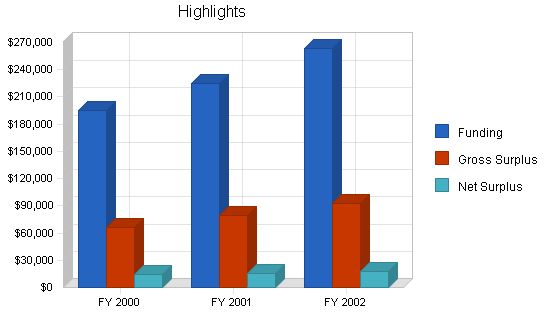
Contents
1.1 Objectives
- Year 1: Fifty members. Year 2: Sixty members.
- Net annual income > $60,000 to support staff and expenses.
1.2 Mission
The Connecticut Motorsports Business Association is a trade association of motorsports businesses in Connecticut and other interested parties. CMBA works to enhance and improve the motorsports business climate in Connecticut. It is a recognized and respected representative and proponent of the motorsports industry.
1.3 Keys to Success
- Over 25 years old, providing a long-standing trade association for Connecticut motorsports businesses.
- One of the few state motorsports organizations with a paid executive director/association management firm.
- Convenient member visits and meetings due to Connecticut’s small size.
Organization Summary
The CMBA has been Connecticut’s only trade association for motorcycle and motorsports businesses since 1974. Our focus is on improving and enhancing the motorsport business climate in Connecticut by:
- Promoting motorsports to the general public
- Protecting the rights of motorsports businesses
- Assisting motorsports businesses to improve sales and profits.
2.1 Legal Entity
The Connecticut Motorsports Business Association, Inc. is a Connecticut nonprofit corporation.
2.2 Organization History
CMBA was founded in 1974 as the Connecticut Motorcycle Dealers Association. In 1992, the name changed to the Connecticut Motorcycle Business Association to include motorcycle accessory shops. In 1995, it became the Connecticut Motorsports Business Association to recognize the selling and servicing of various motorsports products.
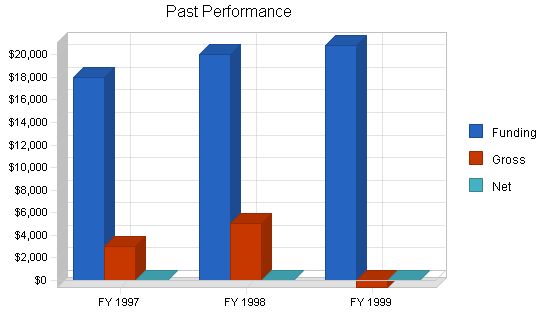
Past Performance
FY 1997 FY 1998 FY 1999
Funding $18,000 $20,000 $20,780
Gross Surplus $3,000 $5,000 ($631)
Gross Surplus % 16.67% 25.00% -3.04%
Operating Expenses $50 $50 $50
Balance Sheet
FY 1997 FY 1998 FY 1999
Current Assets
Cash $11,000 $17,000 $12,000
Other Current Assets $0 $0 $0
Total Current Assets $11,000 $17,000 $12,000
Long-term Assets
Long-term Assets $0 $0 $0
Accumulated Depreciation $0 $0 $0
Total Long-term Assets $0 $0 $0
Total Assets $11,000 $17,000 $12,000
Current Liabilities
Accounts Payable $0 $0 $0
Current Borrowing $0 $0 $0
Other Current Liabilities (interest free) $0 $0 $0
Total Current Liabilities $0 $0 $0
Long-term Liabilities $0 $0 $0
Total Liabilities $0 $0 $0
Paid-in Capital $0 $0 $0
Retained Earnings $11,000 $17,000 $12,000
Earnings $0 $0 $0
Total Capital $11,000 $17,000 $12,000
Total Capital and Liabilities $11,000 $17,000 $12,000
Other Inputs
Payment Days 0 0 0
2.3 Locations and Facilities
Since its inception, the CMBA’s office has been that of its president. Since the mid-1990’s, however, a paid executive director/association management firm has provided housing for the CMBA’s office. At this time we have a modest website and are planning a separate phone line from that of the executive director.
Services
Activities and events:
1. Monthly dinner meetings for information sharing.
2. Lobbying and legislative services.
3. Annual awards banquet.
4. Spring motorcycle show.
5. Winter conference and seminars.
6. Annual Connecticut SuperRide.
7. Permanent rider education facility.
8. Connecticut Motorsports Park.
3.1 Service Description
Government: CMBA employs a professional lobbyist to represent our members with government agencies and the legislature.
3.2 Alternative Providers
While there are no direct competitors, there are other organizations that may solicit our members and prospects.
1. CBIA. Connecticut Business and Industry Association offers group insurance and other benefits to small businesses.
2. CATA. Connecticut Auto Trades Association offers benefits to firms selling motor vehicles.
3. CMTA. Connecticut Marine Trades Association offer benefits to firms selling watercraft.
4. Chambers of Commerce offer incentives to businesses in their local market.
5. National organizations (dealer groups, Lemco Twenty Clubs) offer benefits.
3.3 Printed Collaterals
The management team will develop an organization brochure to explain the benefits of membership to prospective members and associate members.
3.4 Fulfillment
The full-time executive director will personally visit every business in the state involved with motorsports, or otherwise interested in our goals and objectives, to solicit their membership in the Association. In addition, he will contact businesses outside the state that are potential Associate members.
3.5 Technology
The executive director and the Association management team will maintain Windows and Mac capabilities including:
1. Complete email facilities on the Internet for working with members directly through email and website delivery of information.
2. Complete desktop publishing facilities for delivery of reports, announcements, news, and information.
3. Telephone and fax facilities, including a toll-free hot-line for members and consumers.
3.6 Future Services
Among the services planned for the future are:
1. A group insurance medical plan for all members.
2. A group buying plan for all members.
3. Bringing the CMBA members onto the Internet for consumer sales and inter-member product distribution.
4. A permanent rider education facility.
5. A Connecticut Motorsport Park.
Market Analysis Summary
There are over 100 businesses in Connecticut involved with motorsports; from franchised dealers and independent accessory shops, repair facilities, and used vehicle dealers to insurance agencies, distributors, manufacturers, and other interested parties. In addition, there are potential associate members outside the state, such as manufacturers, distributors, insurance companies, and others who service and sell to our members.
4.1 Market Segmentation
1. Franchised dealers.
2. Independent accessory, repair, used motorcycle, parts stores.
3. Insurance companies and agencies.
4. Distributors and manufacturers.
5. Other interested parties.
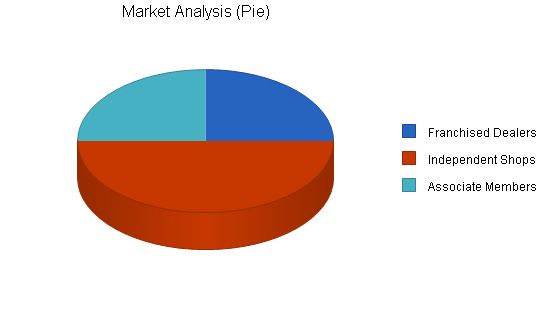
Market Analysis:
The table below provides the growth of potential customers from 1999 to 2003:
Franchised Dealers: -10% growth, 25 (1999) to 17 (2003)
Independent Shops: 0% growth, 50 (1999) to 50 (2003)
Associate Members: 20% growth, 25 (1999) to 52 (2003)
Total: 4.44% growth, 100 (1999) to 119 (2003)
4.2 Target Market Segment Strategy:
Businesses in our industry typically do not join this association willingly; we need to actively recruit new members, particularly independent shops.
4.2.1 Market Trends:
The busy nature of our lives and increasing competitiveness, not only within our industry but also from other products and services, affects our customers’ purchasing decisions. Additionally, mail order and Internet marketers are eroding our market share. However, new motorcycle and powersports equipment sales are on the rise, thanks to increased consumer confidence and spending.
4.2.2 Market Growth:
According to the D.J. Brown Composite Index in Dealernews magazine, the motorcycle industry has experienced seven consecutive years of growth. This growth is not limited to cruisers and sportbikes, but also includes touring bikes and dirtbikes. Sales have increased by 17% since 1998. Powersports research reported that 56% of motorsports customers rely on local dealers for routine service.
4.2.3 Market Needs:
Most of our members and potential members are small businesses with limited resources for training and marketing. We can assist them in improving their profitability and increasing the value of their investments through sales and management training, marketing information, and marketing aids.
Strategy and Implementation Summary:
CMBA will focus on three major projects: Winter Conference combined with Motorcycle Show, SuperRide, and Annual Awards Banquet. Additional revenue will come from monthly dinner meetings (profit from dinner and sponsorships) and advertising sales in the monthly newsletter.
5.1 Strategy Pyramid:
Our main strategy is membership growth, which generates revenue through dues and positions CMBA as the true representative of the Connecticut motorsports industry. To achieve this, we will:
1. Regularly visit and contact potential members within and outside the state.
2. Emphasize the value of membership to attract new members.
3. Increase awareness of the association and its benefits.
Programs to support these tactics include association advertising and promotions, special events, support and development of locations for equipment use and training, legislative and government agency activity, and mutual legal aid and support.
5.2 Value Proposition:
Our members benefit from the collective knowledge and experience of various businesses, saving time and minimizing trial and error. Networking opportunities with peers, industry leaders, and government officials add value beyond the cost of membership. Additionally, members can leverage each other’s inventory for better customer service.
5.3 Competitive Edge:
Effectively persuading independent small-business owners to join our association requires a persuasive presentation of membership benefits. The executive director, along with the Membership Committee, will conduct in-person presentations supported by materials showcasing the value of membership. Increasing the meeting schedule and newsletter frequency will improve communication and raise awareness.
5.4 Marketing Strategy:
Our funding forecast includes strategic plans for different revenue sources. The Winter Conference and Motorcycle Show will be marketed to motorsports businesses in New England and New York. Fundraising programs involve monthly objectives with financial incentives for the executive director to exceed goals. Communication among officers, directors, and the executive director will occur regularly to evaluate progress.
5.4.2 Funding Forecast:
Anticipated funding is summarized in the table and chart below. Revenue projections are based on historical data and adjustments for new initiatives, such as enhanced conference support and partnerships for the Motorcycle Show and SuperRide.
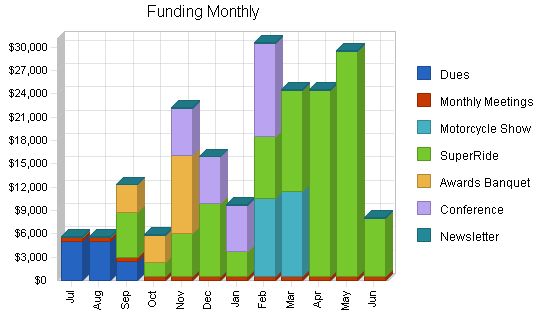
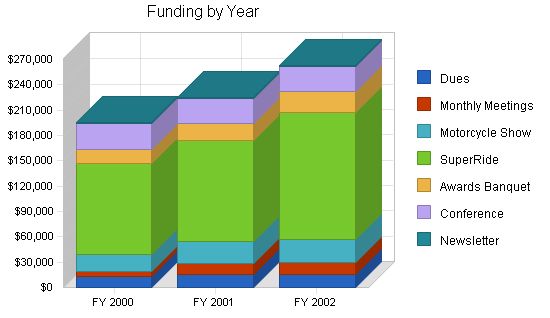
Funding Forecast:
FY 2000 FY 2001 FY 2002
Dues $12,500 $15,000 $15,000
Monthly Meetings $6,000 $14,000 $15,000
Motorcycle Show $21,000 $25,000 $27,000
SuperRide $107,300 $120,000 $150,000
Awards Banquet $17,000 $20,000 $25,000
Conference $30,000 $30,000 $30,000
Newsletter $1,200 $1,200 $1,200
Total Funding $195,000 $225,200 $263,200
Direct Cost of Funding:
FY 2000 FY 2001 FY 2002
Dues $150 $200 $200
Monthly Meetings $4,800 $12,000 $12,000
Motorcycle Show $19,000 $20,000 $22,000
SuperRide $74,700 $80,000 $100,000
Awards Banquet $13,500 $16,000 $18,000
Conference $15,500 $17,000 $17,000
Newsletter $900 $900 $900
Subtotal Cost of Funding $128,550 $146,100 $170,100
5.5 Milestones
The table lists the program milestones, dates, responsible parties, and budgets. The milestone schedule emphasizes planning for implementation.
The commitment behind the table is not shown. Our business plan includes provisions for plan-vs.-actual analysis, and we will hold monthly follow-up meetings to discuss variance and course corrections.
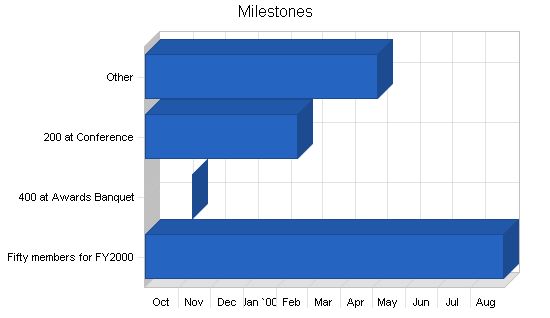
Milestones
| Milestones | |||||
| Milestone | Start Date | End Date | Budget | Manager | Department |
| Fifty members for FY2000 | 9/30/1999 | 8/31/2000 | $12,500 | Essenfield | Membership |
| 400 at Awards Banquet | 11/13/1999 | 11/13/1999 | $17,000 | D’Occhio | Banquet |
| 200 at Conference | 9/30/1999 | 2/20/2000 | $30,000 | Essenfield | Events |
| Other | 9/30/1999 | 5/5/2000 | $110,000 | Essenfield | Events |
| Totals | $169,500 | ||||
Management Summary
The management team consists of the board of directors, officers of CMBA, and the executive director. A professional lobbyist is also employed to monitor legislative activities and help achieve desired outcomes. Work will be divided among committees and additional staff may be hired for the Association management team.
6.1 Personnel Plan
Our personnel expenditures (executive director and lobbyist) for the first three years are summarized in the table below. Compensation will increase from approximately $43K in the first year to around $59K in the third year. This plan balances fairness and efficiency, aligning with our mission statement. The detailed monthly personnel plan for the first year is included in the appendix.
| Personnel Plan | |||
| FY 2000 | FY 2001 | FY 2002 | |
| Executive Director | $39,000 | $44,000 | $53,000 |
| Other | $4,200 | $5,000 | $6,000 |
| Total People | 2 | 2 | 2 |
| Total Payroll | $43,200 | $49,000 | $59,000 |
Financial Plan
- We aim to finance growth solely through cash flow, avoiding the need for member assessments or borrowing.
7.1 Important Assumptions
Notes for Funding chart for 1999-2000 (FY2000):
Revenues:
- Dues revenue assumes 50 members (new and renewing) at $250. Exec. Dir. visits all potential members in the state and contacts potential associate members.
- Meeting revenue assumes 20 people per monthly meeting, paying $25 each for dinner and meeting.
- Motorcycle Show revenue assumes 11,000 consumers at $10 each and 20,000 sq ft at $1 per sq ft.
- SuperRide revenue comes from Registrations, Exhibitors, Advertisers, Sponsors, and Specials. A separate chart is attached for the projected SuperRide forecast.
- Awards Banquet Revenue assumes 400 attendees paying $30 each, plus $5,000 in sponsorships.
- Conference Revenue assumes 200 attendees paying $125 each, plus $5,000 from sponsors and exhibitors.
Costs:
- Motorcycle Show costs include $10,000 for space, $9,000 for advertising, and $1,000 for other expenses.
- SuperRide costs include Promotion expenses, Event costs, and General expenses such as credit card charges and postage for confirmations.
| General Assumptions | |||
| FY 2000 | FY 2001 | FY 2002 | |
| Plan Month | 1 | 2 | 3 |
| Current Interest Rate | 10.00% | 10.00% | 10.00% |
| Long-term Interest Rate | 10.00% | 10.00% | 10.00% |
| Tax Rate | 0.00% | 0.00% | 0.00% |
| Other | 0 | 0 | 0 |
7.2 Projected Surplus or Deficit
Our projected surplus and deficit are shown in the following table. Funding will increase from over $195K in the first year to more than $263K in the third year. Profits may be allocated to legislative activities, marketing activities, or kept as contingencies. The detailed monthly projections are included in the appendix.
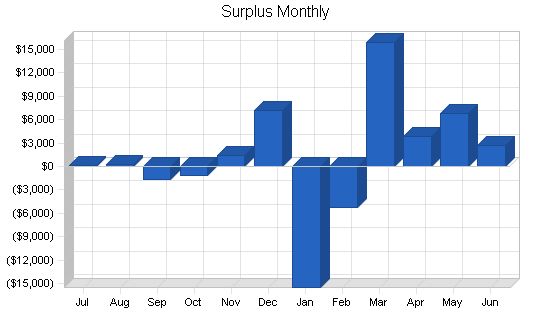
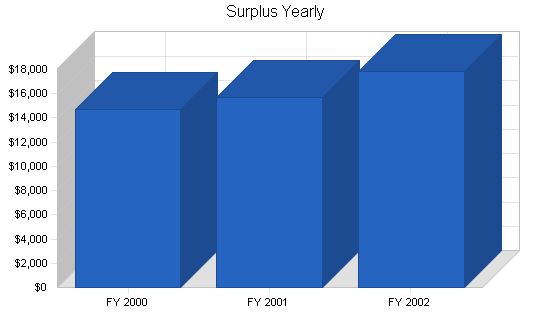
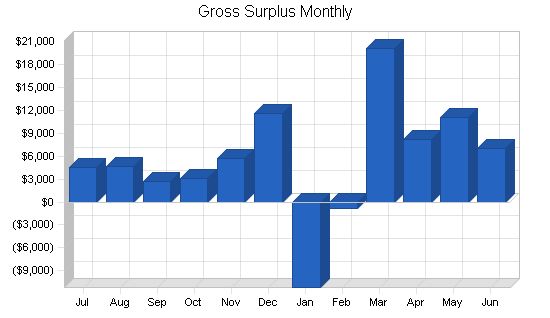
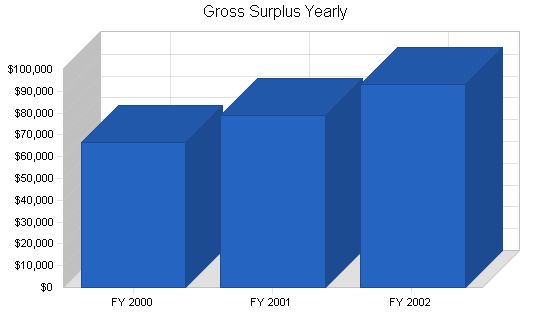
Surplus and Deficit
FY 2000 FY 2001 FY 2002
Funding $195,000 $225,200 $263,200
Direct Cost $128,550 $146,100 $170,100
Other Costs of Funding $0 $0 $0
Total Direct Cost $128,550 $146,100 $170,100
Gross Surplus $66,450 $79,100 $93,100
Gross Surplus % 34.08% 35.12% 35.37%
Expenses
Payroll $43,200 $49,000 $59,000
Marketing/Promotion $1,380 $6,400 $7,450
Depreciation $0 $0 $0
Rent $6,000 $6,500 $7,000
Telephone Service $1,200 $1,500 $1,800
Payroll Taxes $0 $0 $0
Other $0 $0 $0
Total Operating Expenses $51,780 $63,400 $75,250
Surplus Before Interest and Taxes $14,670 $15,700 $17,850
EBITDA $14,670 $15,700 $17,850
Interest Expense $0 $0 $0
Taxes Incurred $0 $0 $0
Net Surplus $14,670 $15,700 $17,850
Net Surplus/Funding 7.52% 6.97% 6.78%
7.3 Projected Cash Flow
Cash flow projections are critical to our success. The monthly cash flow is shown in the illustration, with one bar representing the cash flow per month, and the other the monthly balance. The annual cash flow figures are included here and the detailed monthly numbers are included in the appendix.
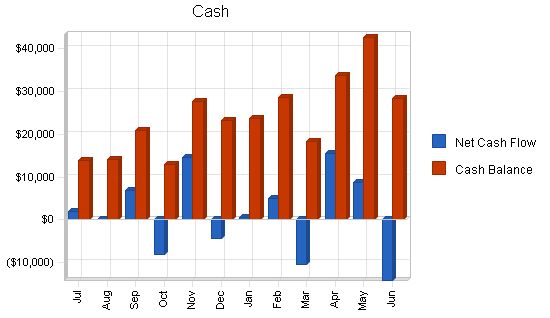
Pro Forma Cash Flow:
| Pro Forma Cash Flow | |||
| FY 2000 | FY 2001 | FY 2002 | |
| Cash Received | |||
| Cash from Operations | |||
| Cash Funding | $195,000 | $225,200 | $263,200 |
| Subtotal Cash from Operations | $195,000 | $225,200 | $263,200 |
| Additional Cash Received | |||
| Sales Tax, VAT, HST/GST Received | $0 | $0 | $0 |
| New Current Borrowing | $0 | $0 | $0 |
| New Other Liabilities (interest-free) | $0 | $0 | $0 |
| New Long-term Liabilities | $0 | $0 | $0 |
| Sales of Other Current Assets | $0 | $0 | $0 |
| Sales of Long-term Assets | $0 | $0 | $0 |
| New Investment Received | $0 | $0 | $0 |
| Subtotal Cash Received | $195,000 | $225,200 | $263,200 |
| Expenditures | |||
| Expenditures from Operations | |||
| Cash Spending | $43,200 | $49,000 | $59,000 |
| Bill Payments | $135,400 | $149,039 | $184,225 |
| Subtotal Spent on Operations | $178,600 | $198,039 | $243,225 |
| Additional Cash Spent | |||
| Sales Tax, VAT, HST/GST Paid Out | $0 | $0 | $0 |
| Principal Repayment of Current Borrowing | $0 | $0 | $0 |
| Other Liabilities Principal Repayment | $0 | $0 | $0 |
| Long-term Liabilities Principal Repayment | $0 | $0 | $0 |
| Purchase Other Current Assets | $0 | $0 | $0 |
| Purchase Long-term Assets | $0 | $0 | $0 |
| Dividends | $0 | $0 | $0 |
| Subtotal Cash Spent | $178,600 | $198,039 | $243,225 |
| Net Cash Flow | $16,400 | $27,161 | $19,975 |
| Cash Balance | $28,400 | $55,562 | $75,536 |
7.4 Projected Balance Sheet:
The balance sheet in the following table shows managed but sufficient growth of net worth and a sufficiently healthy financial position. The monthly estimates are included in the appendix.
| Pro Forma Balance Sheet | |||
| FY 2000 | FY 2001 | FY 2002 | |
| Assets | |||
| Cash | $28,400 | $55,562 | $75,536 |
| Other Current Assets | $0 | $0 | $0 |
| Total Current Assets | $28,400 | $55,562 | $75,536 |
| Long-term Assets | |||
| Long-term Assets | $0 | $0 | $0 |
| Accumulated Depreciation | $0 | $0 | $0 |
| Total Long-term Assets | $0 | $0 | $0 |
| Total Assets | $28,400 | $55,562 | $75,536 |
| Liabilities and Capital | FY 2000 | FY 2001 | FY 2002 |
| Current Liabilities | |||
| Accounts Payable | $1,730 | $13,192 | $15,316 |
| Current Borrowing | $0 | $0 | $0 |
| Other Current Liabilities | $0 | $0 | $0 |
| Subtotal Current Liabilities | $1,730 | $13,192 | $15,316 |
| Long-term Liabilities | $0 | $0 | $0 |
| Total Liabilities | $1,730 | $13,192 | $15,316 |
| Paid-in Capital | $0 | $0 | $0 |
| Accumulated Surplus/Deficit | $12,000 | $26,670 | $42,370 |
| Surplus/Deficit | $14,670 | $15,700 | $17,850 |
| Total Capital | $26,670 | $42,370 | $60,220 |
| Total Liabilities and Capital | $28,400 | $55,562 | $75,536 |
| Net Worth | $26,670 | $42,370 | $60,220 |
7.5 Standard Ratios:
The following table outlines some of the more important ratios from the Convention and Trade Show Organizers industry. The final column, Industry Profile, details specific ratios based on the industry as it is classified by the Standard Industry Classification (SIC) code, 7389.
| Ratio Analysis | ||||
| FY 2000 | FY 2001 | FY 2002 | Industry Profile | |
| Funding Growth | 838.40% | 15.49% | 16.87% | 10.93% |
| Percent of Total Assets | ||||
| Other Current Assets | 0.00% | 0.00% | 0.00% | 76.67% |
| Total Current Assets | 100.00% | 100.00% | 100.00% | 76.67% |
| Long-term Assets | 0.00% | 0.00% | 0.00% | 23.33% |
| Total Assets | 100.00% | 100.00% | 100.00% | 100.00% |
| Current Liabilities | 6.09% | 23.74% | 20.28% | 40.41% |
| Long-term Liabilities | 0.00% | 0.00% | 0.00% | 17.31% |
| Total Liabilities | 6.09% | 23.74% | 20.28% | 57.72% |
| Net Worth | 93.91% | 76.26% | 79.72% | 42.28% |
| Percent of Funding | ||||
| Funding | 100.00% | 100.00% | 100.00% | 100.00% |
| Gross Surplus | 34.08% | 35.12% | 35.37% | 100.00% |
| Selling, General & Administrative Expenses | 26.55% | 28.15% | 28.59% | 76.26% |
| Pro Forma Balance Sheet | |||||||||||||
| Jul | Jun | ||||||||||||
| Assets | Starting Balances | ||||||||||||
| Cash | $12,000 | $13,939 | $14,104 | $20,920 | $12,964 | $27,617 | $23,227 | $23,687 | $28,647 | $18,357 | $33,767 | $42,510 | $28,400 |
| Other Current Assets | $0 | ||||||||||||
| Total Current Assets | $12,000 | $13,939 | $14,104 | $20,920 | $12,964 | $27,617 | $23,227 | $23,687 | $28,647 | $18,357 | $33,767 | $42,510 | $28,400 |
| Long-term Assets | |||||||||||||
| Long-term Assets | $0 | ||||||||||||
| Accumulated Depreciation | $0 | ||||||||||||
| Total Long-term Assets | $0 | ||||||||||||
| Total Assets | $12,000 | $13,939 | $14,104 | $20,920 | $12,964 | $27,617 | $23,227 | $23,687 | $28,647 | $18,357 | $33,767 | $42,510 | $28,400 |
| Liabilities and Capital | |||||||||||||
| Current Liabilities | |||||||||||||
| Accounts Payable | $0 | $1,779 | $1,634 | $10,140 | $3,374 | $16,617 | $5,017 | $20,967 | $31,117 | $5,017 | $16,617 | $18,550 | $1,730 |
| Current Borrowing | $0 | ||||||||||||
| Other Current Liabilities | $0 | ||||||||||||
| Subtotal Current Liabilities | $0 | $1,779 | $1,634 | $10,140 | $3,374 | $16,617 | $5,017 | $20,967 | $31,117 | $5,017 | $16,617 | $18,550 | $1,730 |
| Long-term Liabilities | $0 | ||||||||||||
| Total Liabilities | $0 | $1,779 | $1,634 | $10,140 | $3,374 | $16,617 | $5,017 | $20,967 | $31,117 | $5,017 | $16,617 | $18,550 | $1,730 |
| Paid-in Capital | $0 | ||||||||||||
| Accumulated Surplus/Deficit | $12,000 | $12,000 | $12,000 | $12,000 | $12,000 | $12,000 | $12,000 | $12,000 | $12,000 | $12,000 | $12,000 | $12,000 | $12,000 |
| Surplus/Deficit | $0 | $160 | $470 | ($1,220) | ($2,410) | ($1,000) | $6,210 | ($9,280) | ($14,470) | $1,340 | $5,150 | $11,960 | $14,670 |
| Total Capital | $12,000 | $12,160 | $12,470 | $10,780 | $9,590 | $11,000 | $18,210 | $2,720 | ($2,470) | $13,340 | $17,150 | $23,960 | $26,670 |
| Total Liabilities and Capital | $12,000 | $13,939 | $14,104 | $20,920 | $12,964 | $27,617 | $23,227 | $23,687 | $28,647 | $18,357 | $33,767 | $42,510 | $28,400 |
| Net Worth | $12,000 | $12,160 | $12,470 | $10,780 | $9,590 | $11,000 | $18,210 | $2,720 | ($2,470) | $13,340 | $17,150 | $23,960 | $26,670 |

Business Plan Outline
- Executive Summary
- Organization Summary
- Services
- Market Analysis Summary
- Strategy and Implementation Summary
- Management Summary
- Financial Plan
- Appendix
Hello!
I’m Andrew Brooks, a seasoned finance consultant from the USA and the mind behind phonenumber247.com.
My career is built on a foundation of helping individuals and businesses thrive financially in an ever-changing economic landscape. At phonenumber247.com, my aim is to demystify the complex world of finance, providing clear, actionable advice that can help you navigate your financial journey with confidence. Whether it’s personal finance management, investment strategies, or understanding the nuances of market dynamics, I’m here to share insights and tools that can propel you towards your financial goals.
Welcome to my digital space, where every piece of advice is a step closer to financial clarity and success!
